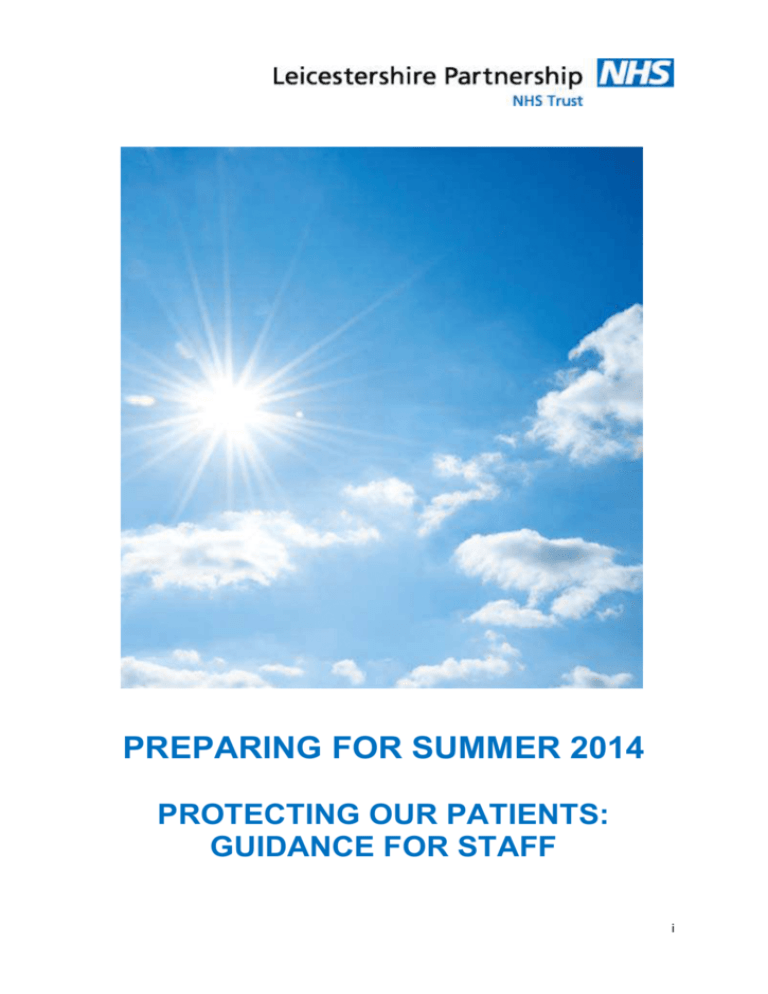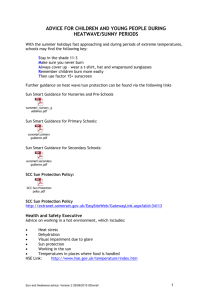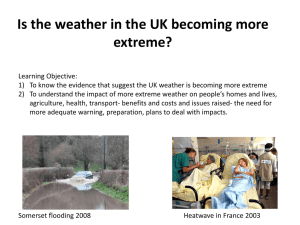Guidance for staff
advertisement

PREPARING FOR SUMMER 2014 PROTECTING OUR PATIENTS: GUIDANCE FOR STAFF i CONTENTS 1 HEATWAVES WHO IS AT RISK 1 2 PLANNING FOR A HEATWAVE: KNOWING WHO ARE OUR AT RISK PATIENTS 2 3 HEAT RELATED ILLNESSES 2 4 MEDICATIONS THAT MAY INCREASE RISK IN PATIENTS DURING HOT WEATHER 3 5 ADVICE TO GIVE TO PATIENTS / SERVICE USERS / CARERS AND RELATIVES ON HOW TO KEEP COOL DURING HOT WEATHER 4 6 EMERGENCY TREATMENT FOR HEATSTROKE 5 7 HOT WEATHER AND HEATWAVE: WELFARE ADVICE FOR STAFF 6 8 FORECASTING HEATWAVES - MET OFFICE HEAT HEALTH WATCH SYSTEM 7 9 RESPONDING TO HEAT HEALTH WATCH ALERTS: ACTIONS FOR MANAGERS & STAFF 8 APPENDIX 1 RAMADAN – ADVICE OF FASTING DURING HOT WEATHER APPENDIX 2 FURTHER INFORMATION ii 1: HEATWAVES: WHO IS AT RISK During heatwaves we can experience high temperatures for prolonged periods. During the heatwave of 2003 over 2000 excess deaths occurred in England and Wales. In response Public Health England and NHS England annually issue a Heatwave Plan which outlines the risks during hot weather and the measures NHS staff should take to protect vulnerable patients and service users. It is known that people with underlying medical conditions are particularly at risk during heatwaves, especially those with cardiovascular and respiratory diseases as these are the main causes of illness and death during hot weather. High Risk Groups: Older Adults (especially over 75 years old). Chronic and severe illness: including heart conditions, diabetes, respiratory and renal conditions, obesity, severe mental illnesses, Parkinson’s disease and difficulties with mobility, Peripheral vascular conditions, Alzheimer’s or related diseases. Those on medications that potentially affect renal function, sweating, thermoregulation or electrolyte balance as this can make this group more vulnerable to the effects of heat. Those on mutli-medications. Inability to adapt behaviour to keep cool: Alzheimer patients, disabled, being bed bound or the very young. Those with severe physical or mental health illnesses. Alcohol or drug dependent. Domestic/personal/occupational circumstances that may increase the risk to health during hot weather (homelessness, live in south-facing housing (especially top floor flats)). During extreme heatwaves when we can experience very high temperatures, fit and healthy people can also be affected. Children Children’s susceptibility to high temperatures varies; those who are overweight or who are taking medications may be at increased risk of adverse effects. Children under four years of age are also at increased risk. Some children with disabilities or complex health needs may be more susceptible to temperature extremes. 1 2: PLANNING FOR A HEATWAVE: KNOWING WHO ARE OUR AT RISK PATIENTS Heatwaves can happen suddenly, and rapid rises in temperature affect vulnerable people very rapidly. A rise in mortality as a result of warm weather can occur within 2 days of an increase in temperatures. Therefore it is important that we are prepared for supporting patients during hot weather. Using care plans LPT staff should assess which individuals are at particular risk, providing them with guidance (see section 5) and identifying what extra help they might need. Things also to consider: Does the patient’s care plan include contact numbers for their GP, care workers and informal carers. Check that the patient knows who to contact if they need assistance and that extra care and support is available if necessary. Anyone in a high-risk category who is living alone is likely to need at least daily contact during hot weather. Older people with chronic or serious illness, mobility problems, or severe mental illness, those who are on certain medications, or those living in accommodation that is hard to keep cool, may need extra care and support. 3: HEAT-RELATED ILLNESSES The main causes of illness and death during a heatwave are Respiratory and Cardiovascular diseases. Additionally, there are specific heat-related illnesses including: Heat cramps – caused by dehydration and loss of electrolytes, often following exercise. Heat rash – small, red, itchy papules. Heat oedema – mainly in the ankles, due to vasodilation and retention of fluid. Heat syncope – dizziness and fainting, due to dehydration, vasodilation, cardiovascular disease and certain medications. Heat exhaustion – is more common. It occurs as a result of water or sodium depletion, with non-specific features of malaise, vomiting and circulatory collapse, and is present when the core temperature is between 37ºC and 40ºC. Left untreated, heat exhaustion may evolve into heatstroke. Heatstroke – can become a point of no return whereby the body’s thermoregulation mechanism fails. This leads to a medical emergency, with symptoms of confusion; disorientation; convulsions; unconsciousness; hot dry skin; and core body temperature exceeding 40ºC for between 45 minutes and eight hours. It can result in cell death, organ failure, brain damage or death. Heatstroke can be either classical or through exertion. 2 4: MEDICATIONS THAT MAY INCREASE RISK IN PATIENTS DURING HOT WEATHER1 The following drugs are theoretically capable of increasing risk in susceptible individuals. It may be worth carefully reviewing the medication such individuals are taking, and assessing the risks and benefits of any changes to their regime. Those causing dehydration Diuretics, especially loop diuretics or electrolyte imbalance Any drug that causes diarrhoea or vomiting (colchicines, antibiotics, codeine) Those likely to reduce renal function NSAIDS, sulphonamides, indinavir, cyclosporin Those with levels affected Lithium, digoxin, antiepileptics, biguanides, statins by dehydration Those that interfere with thermoregulation: By central action By interfering with sweating Neuroleptics, serotoninergic agonists Anticholinergics: atropine, hyoscine tricyclics H1 (first generation) antihistamines certain antiparkinsonian drugs certain antispasmodics neuroleptics disopyramide antimigraine agents Vasoconstrictors Those reducing cardiac output: beta blockers diuretics By modifying basal metabolic rate Thyroxine Drugs that exacerbate the effects of heat by reducing arterial pressure All antihypertensives Antianginal drugs Drugs that alter states of alertness (including those in section 4 (Central Nervous System) of the British National Formulary)- particularly 4.1 (Hypnotics and Anxiolytics) and 4.7 (Analgesics). 1 Taken from Public Health England: Heatwave Plan for England 2014 3 5: ADVICE TO GIVE TO PATIENTS / SERVICE USERS / CARERS AND RELATIVES ON HOW TO KEEP COOL DURING HOT WEATHER How to keep out the heat: Keep curtains on windows exposed to the sun closed while the temperature outside is higher than it is inside. Once the temperature outside has dropped lower than it is inside, open the windows. This may require late night visiting and such advice needs to be balanced by any possible security concerns. Advise the person to stay out of the sun, especially between the hours of 11.00am and 3.00pm. Advise them to stay in the shade and to wear hats, sunscreen, thin scarves and light clothing if going outside. How to keep body temperatures down: Ensure that the person reduces their levels of physical exertion. Suggest they take regular cool showers or baths, or at least an overall body wash. Advise them to wear light, loose cotton clothes to absorb sweat and prevent skin irritation. Suggest that they sprinkle their clothes with water regularly, and splash cool water on their face and the back of their neck. A damp cloth on the back of the neck helps temperature regulation. Recommend cold food, particularly salads and fruit with a high water content. Advise them to drink regularly, preferably water or fruit juice, but avoid alcohol and caffeine (tea, coffee, colas). – Note: Check whether the individual has access to a fridge / cool drinking water. Monitor their daily fluid intake, particularly if they have several carers or are not always able to drink unaided. Provide extra care for high risk patients: Keep in regular contact throughout the heatwave, and try to arrange for someone to visit / call at least once a day. Keep giving advice on what to do to help keep cool. Older people with chronic or serious illness, mobility problems, or severe mental illness, those who are on certain medications, or those living in accommodation that is hard to keep cool, may need extra care and support. During extended periods of raised temperatures ensure that persons over the age of 65 are advised to increase their fluid intake to reduce the risk of bloodstream infections caused by Gram-negative bacteria. Further guidance is available from NHS Choices on: http://www.nhs.uk/livewell/summerhealth/ 4 Be alert:As well as the specific symptoms of heat exhaustion and heatstroke, watch out for signs in patients / service users that could be attributed to other causes, such as: Difficulty sleeping, drowsiness, faintness and changes in behaviour; Increased body temperature; Difficulty breathing and increased heart rate; Dehydration, nausea or vomiting; or Worsening health problems, especially of heart or respiratory system. 6: EMERGENCY TREATMENT FOR HEATSTROKE If you suspect someone has heatstroke, call 999. While waiting for the ambulance: Take the person’s temperature; If possible, move them somewhere cooler; Cool them down as quickly as possible by giving them a cool shower, sprinkling them with water or wrapping them in a damp sheet, and using a fan to create an air current; Encourage them to drink fluids, if they are conscious; Give them a saline drip and oxygen if they are unwell; and Do not give aspirin or paracetamol. 5 7: HOT WEATHER AND HEATWAVE: WELFARE ADVICE FOR STAFF Work Environment: Ensure staff have access to cool drinking water. Use blinds / curtains to shade windows from direct light. Open windows during late evening / morning to bring cooler air into the building. Especially if this encourages a breeze. However:o Be mindful of security risk. o Do not open windows in air-conditioned rooms as this will counter act the air-conditioning. Report any air-conditioning faults to Interserve. Use fans if available. Staff: Keep taking in fluids (water and juices rather than coffee and tea). Try and eat salads and food with a high liquid content. Try and minimise physical exertion as is practicable. Managers to allow staff to take breaks from particularly warm rooms – especially if cooler or air – conditioned rooms are available. Managers to consider relaxing dress code to allow staff to wear lighter clothes (where this does not contravene clinical / infection control requirements. Managers to be mindful of staff who may be more vulnerable during hot weather (due to medication, pregnant, chronic health condition). 6 8: FORECASTING HEATWAVES - MET OFFICE HEAT HEALTH WATCH SYSTEM Linked to the Public Health England Heatwave Plan is the Met Office’s Heat Health Watch Alert System which operates from the 1st June until the 15th September. This system aims to provide the public and health and social care organisations with advance warning of hot temperatures. Weather Forecasts / Heatwave Alerts are available from the Met Office on: Website: http://www.metoffice.gov.uk/ Twitter @metoffice As with severe winter weather, in the event that the Heatwave Alert Levels are escalated the Met Office would use all media routes to inform the public. MET OFFICE HEAT HEALTH WATCH ALERT LEVELS 7 9: RESPONDING TO HEAT HEALTH WATCH ALERTS: ACTIONS FOR MANAGERS & STAFF In the event that the Met Office forecasts Hot Weather or a Heatwave and escalates the Heatwave Alert Levels from 1 through to 4, the alerts are automatically forwarded to LPT directors and all managers on LPT’s On-Call rotas, for consideration and if necessary action. HEATWAVE: KEY ACTIONS FOR HEALTHCARE PROFESSIONAL Level 1 Heatwave and Summer Preparedness 1 June – 15 September Community Services Understand those patient groups who are at risk during hot weather. Identify high-risk individuals on your caseload and raise awareness of heat illnesses and their prevention among patients, service users and their carers. Raise awareness of patients to the potential dangers to health during hot weather. Include risk in care records and consider whether changes might be necessary to care plans in the event of a heatwave (e.g. initiating daily visits by formal or informal care givers for those living alone). In-Patient Facilities Identify or create cool rooms/areas (able to be maintained below 26°C). Install thermometers where vulnerable individuals spend substantial time. Level 2 – Heatwave is forecast – 60 per cent risk of heatwave in 2-3 days Community Services Check high-risk people have visitor/phone call arrangements in place. Reaffirm key messages to patients, service users and carers to the potential dangers to health during hot weather. In-Patient Facilities Communicate alerts to staff and make sure that they are aware of the need to ensure patients are kept cool. Review and prioritise high-risk people. Monitor patients for any indications that they are being affected by the heat. Check indoor temperatures are recorded regularly during the hottest periods for all areas where patients reside. Keep windows shaded on the sunny side of the building. Ensure a cool area is available as respite for patients and staff (should be below 26°C). Ensure there is sufficient access to cold water / ice to prevent dehydration. Consider weighing clients regularly to identify dehydration and rescheduling physio to cooler hours. If fans are used make sure they do not present a risk to patients or staff. Note: Need to ensure patients are taking sufficient fluids to prevent dehydration that might be caused by the air movement. 8 Level 3 – Heatwave Action – temperature reached in one or more Met Office National Severe Weather Warning Service regions As Level 2 Plus: Community Services Visit/phone high-risk people. Reaffirm key messages to patients, service users and carers to the potential dangers to health during hot weather. Advise carers to contact GP if concerns re health. In-Patient Facilities Managers to ensure sufficient staff available to support vulnerable patients. Check indoor temperatures are recorded regularly during the hottest periods for all areas where patients reside. Ensure staff can help and advise clients including access to cool rooms, close monitoring of vulnerable individuals, reducing internal temperatures through shading, turning off unnecessary lights/equipment, cooling building at night, ensuring discharge planning for at risk patient takes the hot weather into account. Level 4 – Major incident – Emergency response Central Government will declare a Level 4 alert in the event of severe or prolonged heatwave affecting sectors other than health and if requiring coordinated multi-agency response LPT ACTIONS: Continue actions as per Level 3 unless advised to the contrary. During extreme conditions, it is not only high-risk groups that may be at risk. Therefore, further risk appraisals should be made of patients and service users. LPT to co-ordinate response to any increase in demand on the health community with health and social care partners under the Leicester, Leicestershire and Rutland Capacity and Demand Management Plan Senior Managers / On-Call Manaagers / On-Call Directors to determine whether there is a need for holding incident teams to consider adoption of special measures to support vulnerable patients. As requested provide Situation reports to CCGs and / or NHS England on the impact of the heatwave on patient care. 9 APPENDIX 1: RAMADAN – ADVICE OF FASTING DURING HOT WEATHER Ramadan, the Muslim month of fasting, is expected to occur from 28 th June to 27th July 2014 (subject to the Islamic lunar calendar). During Ramadan, members of the Muslim community may fast during daylight hours. For Muslims, Ramadan is the most virtuous month of the year and one fast maintained during this month far outweighs consecutive fasting in any other month. Because of this, there is a strong motivation to fast in Ramadan, even if unwell, and breaking the fast can lead to great remorse. Islamic teachings are very clear in pardoning those who are unwell from fasting. However we know from experience that patients are often very reluctant to accept this from ‘non-religious authority’ and will attempt to fast, putting their health at risk. Our spiritual and pastoral care team advises that, while we should make every effort to support patients who are able and willing to fast during Ramadan, where there are concerns it is paramount our Muslim chaplain – Fazlur Diwan - is involved in any discussions about either allowing a patient to fast, or offering them the option not to fast. He is available to any LPT staff to provide guidance, information and to offer support to your patients/service users during Ramadan. You can contact him via the service on 0116 295 7569 or 07795 332 742. Fasting and health during a heatwave: In hot weather dehydration can pose a serious and common risk, and it is important to balance food and fluid intake between fasts, and especially to drink enough water. If someone starts to feel unwell, disoriented or confused, or collapses or faints, the advice is to stop fasting and have a drink of water or other fluid. This is especially important for older adults, those with poorly controlled medical conditions such as low or high blood pressure, diabetes and those who are receiving dialysis. The Muslim Council of Britain has confirmed that breaking fast in such conditions is allowable under Islamic law. It is also important to check on others in the community who might be at greater risk and keep an eye on children to ensure they are having a safe and healthy Ramadan. Guidance has been produced to help ensure members of the Muslim community have a safe and healthy Ramadan: http://www.ramadan.co.uk/RamadhanHealth_Guide.pdf NHS Choices – Healthy Ramadan: http://www.nhs.uk/livewell/healthyramadan/Pages/healthyramadanhome.aspx Muslim Council of Britain: http://www.mcb.org.uk/ramadan/healthadvice.html 10 APPENDIX 2: FURTHER INFORMATION Public Health England: Heatwave Plan for England 2014 Public Health England: Heatwave Plan for England – Advice for Health and Social Care Professionals Public Health England: Heatwave Plan for England – Advice for Managers and Staff. NHS Choices: www.nhs.uk/summerhealth Met Office: www.metoffiice.gov.uk 11






![About Heatwaves [WORD 511KB]](http://s3.studylib.net/store/data/006651441_1-a84046430e26dbbf57769d77a947717e-300x300.png)




